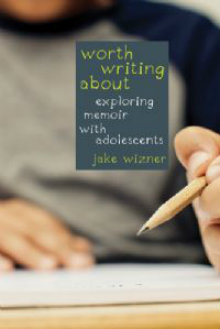Exploring Memoir Writing with Adolescents
Worth Writing About: Exploring Memoir with Adolescents
By Jake Wizner
(Stenhouse Publishers, 2015 – Learn more)
 Reviewed by Mary Langer Thompson
Reviewed by Mary Langer Thompson
Jake Wizner has done what few teachers would ever attempt—teach memoir writing to eighth graders and have them tell their own stories. Most would say eighth graders are too young, that they haven’t had enough life experience to attempt this popular genre. But Wizner has been teaching his two-month unit for almost two decades (see five reasons why he teaches memoir), and I am thankful for this guide for other teachers.
 What makes this book excellent is that it is based on three main principles or assumptions about teaching writing. One is that the writing teacher should use models and prompts. The prologue begins with the end product.
What makes this book excellent is that it is based on three main principles or assumptions about teaching writing. One is that the writing teacher should use models and prompts. The prologue begins with the end product.
Wizner begins his unit by reading aloud an excerpt from a former student who wrote “The Rice Bowl.” The model, given in full, is gripping, so it will motivate students from the very beginning. There are many more models or “mentor texts” throughout the book, from both published authors and students. Some are humorous, and there is even a graphical memoir.
Chapter two gets practical with 10 prompts to help students reflect and generate memories. One of my favorites is to have students walk around their room or house to find significant objects, objects with memories associated with them. Another valuable prompt is to have students write about areas of conflict in depth because “without conflict there is no story.” Wizner assures students that there may be areas that they are not comfortable sharing and that he understands.
Other chapters deal with fact and truth, story and understory, beginnings and endings, setting and theme, assessment and evaluation (see the memoir rubric), drafts and revisions. The entire chapter on struggling students and an appendix for modifying instruction for students with IEPs are both unique and extremely useful.
A second belief is that reading is connected to writing. Included is an entire chapter on the reading-writing connection in which Wizner quotes Steven Spielberg: “Only a generation of readers will spawn a generation of writers.” There is also a bibliography divided by grade level (6 and up, 8 and up, 10 and up).
The third basic assumption is that the teacher must do what he or she is requiring students to do. Wizner is a writer himself, a novelist, so this might be easier for him than for other teachers, but how can we expect students to do what we are not willing to attempt ourselves?
This book is everything a teacher needs to teach memoir at any level, and even fits well with the Common Core. More importantly, Wizner wants students to love writing while asking, “Who am I?” and he convinced this reader that this genre is highly accessible to all students.
Even if you don’t plan to teach memoir, read the book for the high-interest excerpts and to gain insight into students’ thoughts and lives. You may even decide to use the prompts and models to write your own memoir.
Mary Langer Thompson, a retired secondary English teacher and elementary principal, is a published poet and author who now writes full time. This past year she was director of the Dorothy C. Blakely Memoir Project, a collaboration between the California Writers Club, High Desert Branch and the Academy for Academic Excellence in Apple Valley, California. High school seniors wrote memoirs of senior citizens and became published authors in All Our Yesterdays.


































